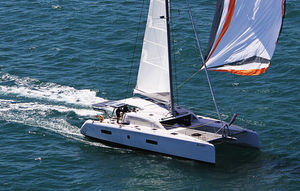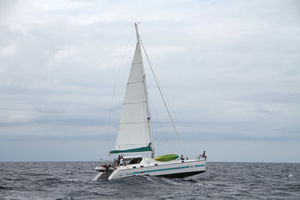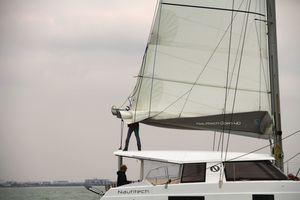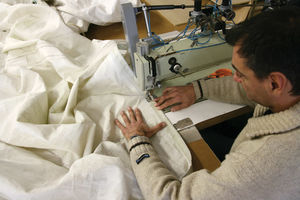
Issue #: 176
Published: March / April 2021
- Price per issue - digital : 6.50€Digital magazine
- Price per issue - print : 8.50€Print magazine
- Access to Multihulls World digital archives Digital archives
What sailor hasn’t had sail damage? A tear in the spinnaker, a slider or a reefing cringle torn out, batten pocket or leech ripped, sailcloth burnt by UV rays. We take a look at some of the most common types of damage... and ways to repair them before heading for the sail loft.
A TEAR IN THE SPI

The tack of this spinnaker has just failed, right at the edge of the reinforcing. A not so unusual occurrence in strong winds.
AT SEA. Once hoisted, the spinnaker is only likely to be damaged in very strong winds. In moderate conditions, it’s during hoisting and dropping that clevis pins, split rings and (poorly protected) spreaders will take great pleasure in tearing the sailcloth. When gybing, the bowsprit or the radar can perforate the spinnaker. As long as the tear is no more than 12 inches (30 cm), the spinnaker can hold out, on the condition that you call Insigna sail repair tape to the rescue! Cut out a patch, round off the corners and stick it on. Then do the same on the other side.
ASHORE. Cleaning with acetone before sticking on an adhesive patch, in the case of a small rip. For a bigger tear, the nylon is laid flat and pinned out via the stitching holes. A patch is cut out, stuck down and sewn. The old cloth is cut away on the other side. It is also possible to replace one or more widths.
MAINSAIL SLIDER (OR BATTEN CAR) RIPPED OFF

AT SEA. When furling the mainsail, or taking in a reef, if the topping lift is left slack and the foot is tight, the boom will drop down onto the bimini or into the cockpit. The bottom slider is then taking a considerable tractive force...until it rips off. Is the weather fine? Then just remove the damaged slider. But if the wind gets up again, take in a reef a bit earlier than usual, to relieve the strain on the slider above.
ASHORE. After removing the eyelet, a strip of cloth is sewn over the damaged spot. As with the spinnaker, the old cloth is cut out on the back of the patch. A triangular reinforcement is then sewn in before a new eyelet is fitted. All that then remains is to slip the slider or batten car back on again
TORN BATTEN POCKET

AT SEA. Taking too long to take in a reef, or a problem that compels you to slow down: the mainsail flogs, causing violent movement in the batten area...until a batten pocket gives way. First thing to do: lower the sail quickly to regain control: if the batten is too far forward, it can pierce the sail a second time and also get caught in the spreaders. Once the sail is on the deck or down below, drill a small hole in both the sail and the batten, at the after end. Beware of fiberglass dust: it’s itchy! Then you can tie a simple lashing through the whole thing. This repair will hold until you get where you’re going
ASHORE. With his unpicker, a kind of needle with a cutting edge, the sailmaker removes the old stitches and the damaged section. The new patch is cut out in double thickness, before being stuck down and sewn..
TORN LEECH

AT SEA. Prolonged flogging for the mainsail, poorly adjusted genoa leech line, and above all, shrouds and poorly protected spreaders are the main causes of tears in the leech. Most of the time, the damage won’t be too bad since the tear usually stops at the end of the particular panel of ...
What readers think
Post a comment
No comments to show.